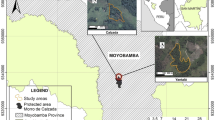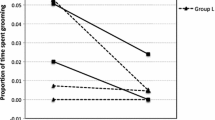Abstract
Mother-infant dyads were observed among three populations of rhesus monkeys (Macaca mulatta) in India and Nepal. Physical contact between mothers and infants, essential for effective maternal care in rhesus, was found to be influenced by the mothers' feeding behavior. As early as the second week of life, infants exhibited a diminished probability of being in contact with their mothers if their mothers were feeding rather than resting. Rhesus mothers disproportionately rejected their infants within feeding contexts, indicating that mothers were actively discouraging contact attempts by their infants during feeding bouts—perhaps because an active infant, if it remained in contact, would diminish its mother's foraging efficiency.
In contrast to the mothers' feeding behavior, mother-infant contact was found to be little influenced by maternal locomotion. Most infants were found to be neither disproportionately in, nor out of contact while their mothers were in motion. However, as the amount of time mothers spent walking increased, so did the probability that infants would be carried. These data suggest that rhesus mothers behave so as to minimize their energetic costs during locomotion.
Similar content being viewed by others
References
Altmann, J., 1974. Observational study of behaviour: sampling methods.Behaviour, 49: 227–267.
————, 1980.Baboon Mothers and Infants. Harvard Univ. Press, Cambridge.
————, 1983. Costs of reproduction in baboons (Papio cynocephalus). In:Behavioral Energetics: The Cost of Survival in Vertebrates,W. P. Aspey &S. I. Lustick (eds.), Ohio State Univ. Press, Columbus, pp. 67–88.
Berman, C. M., 1980. Mother-infant relationships among free-ranging rhesus monkeys on Cayo Santiago: a comparison with captive pairs.Anim. Behav., 28: 860–873.
Chalmers, N. R., 1972. Comparative aspects of early infant development in some captive Cercopithecines. In:Primate Socialization,F. Poirier (ed.), Random House, New York, pp. 63–82.
Clutton-Brock, T. H. & P. H. Harvey, 1983. The functional significance of variation in body size among mammals. In:Advances in the Study of Mammalian Behavior. Special Publication No. 7,J. F. Eisenberg & D. G. Kleiman (eds.), Amer. Soc. of Mammalogists, pp. 632–663.
Cohen, J. &P. Cohen, 1983.Applied Multiple Regression/Correlation Analysis for the Behavioral Sciences. Erlbaum, Hillsdale, N.J.
Givoni, B. &R. F. Goldman, 1971. Predicting metabolic energy cost.J. Appl. Physiol., 30: 429–433.
Johnson, R. L., 1985. Mother-infant relations among wild populations of rhesus monkeys in India and Nepal. Ph.D. thesis, Univ. of Colorado, Boulder, Colorado.
———— &C.H. Southwick, 1984. Structural Diversity and mother-infant relations among rhesus monkeys in India and Nepal.Folia Primatol., 43: 198–215.
Lee, P. C., 1983. Ecological influences on relationships and social structure. In:Primate Social Relationships,R. A. Hinde (ed.), Sinauer, Sunderland, Mass., pp. 225–229.
Marriott, B., 1978. Feeding patterns of wild rhesus monkeys (Macaca mulatta) in Kathmandu.Nepal Fed. Proc., 37: 759.
Nash, L. T., 1978. The development of the mother-infant relationship in wild baboons (Papio anubis).Anim. Behav., 26: 746–759.
Paul, A. &D. Thommen, 1984. Timing of birth, female reproductive success, and infant sex ratio in semifree-ranging Barbary macaques (Macaca sylvanus).Folia Primatol., 42: 2–16.
Pereira, M. E. &J. Altmann, 1985. Development of social behavior in free-living nonhuman primates. In:Nonhuman Primate Models for Human Growth and Development,E. S. Watts (ed.), Alan Liss, New York, pp. 217–309.
Plimpton, E., 1981. Environmental variables and the response to maternal loss. Ph.D. thesis, Downstate, Medical Center, New York.
Rhine, R. J., G. W. Norton, &B. J. Westlund, 1984. The waning of dependence in infant free-ranging yellow baboons (Papio cynocephalus) of Mikumi National Park.Amer. J. Primatol., 7: 213–228.
Rosenblum, L. A., 1971. The ontogeny of mother-infant relations in macaques. In:Ontogeny of Vertebrate Behavior,H. Moltz (ed.), Academic Press, New York, pp. 315–367.
————, &G. Sunderland, 1982. Feeding ecology and mother-infant relations. In:Parenting: Its Causes and Consequences,L. W. Hoffman,R. Gandelman, &H. R. Schiffman (eds.), Erlbaum, Hillsdale, N. J., pp. 75–110.
Rowell, T., 1972.Social Behaviour of Monkeys. Penguin, Baltimore.
Schwartz, G. G. &L. A. Rosenblum, 1983. Allometric influences on primate mothers and infants. In:Symbiosis in Parent-offspring Interactions,L. A. Rosenblum &H. Moltz (eds.), Plenum Press, New York, pp. 215–248.
Siddiqi, M. F. &C. H. Southwick, 1980. Food habits of rhesus monkeys in north central India.Proc. Zool. Soc. Calcutta, 31: 53–61.
Silk, J. B., 1980. Kidnapping and female competition among captive bonnet macaques.Primates, 21: 100–110.
Soule, R. G., K. B. Randolf, &R. F. Goldman, 1978. Energy expenditure of heavy load carriage.Ergonomics, 21: 373–381.
Southwick, C. H., T. Richie, H. Taylor, H. J. Teas, &M. F. Siddiqi, 1980. Rhesus monkey populations in India and Nepal: patterns of growth, decline, and natural regulation. In:Biosocial Mechanisms of Population Regulation,M. N. Cohen,R. S. Malpass, &H. G. Klein (eds.), Yale Univ. Press, New Haven, pp. 151–170.
————, &M. F. Siddiqi, 1985. The rhesus monkey's fall from grace.Nat. Hist., 94: 62–71.
Struhsaker, T., 1971. Social behaviour of mother and infant vervet monkeys (Cercopithecus aethiops).Anim. Behav., 19: 233–250.
Suomi, S. J., 1978. Development of attachment and other social behaviors in rhesus monkeys. In:Attachment Behavior,J. Alloway,P. Pliner, &L. Krames (eds.), Plenum Press, New York, pp. 197–224.
Sussman, R. W., 1977. Socialization, social structure, and ecology of two sympatric species ofLemur. In:Primate Bio-social Development,S. Chevalier-Skolnikoff &F. E. Poirier (eds.), Garland, New York, pp. 515–528.
Teas, J., 1978. Behavioral ecology of rhesus monkeys (Macaca mulatta) in Kathmandu, Nepal. Ph.D. thesis, The Johns Hopkins Univ., Baltimore.
Author information
Authors and Affiliations
About this article
Cite this article
Johnson, R.L. Mother-infant contact and maternal maintenance activities among free-ranging rhesus monkeys. Primates 27, 191–203 (1986). https://doi.org/10.1007/BF02382598
Received:
Accepted:
Issue Date:
DOI: https://doi.org/10.1007/BF02382598




